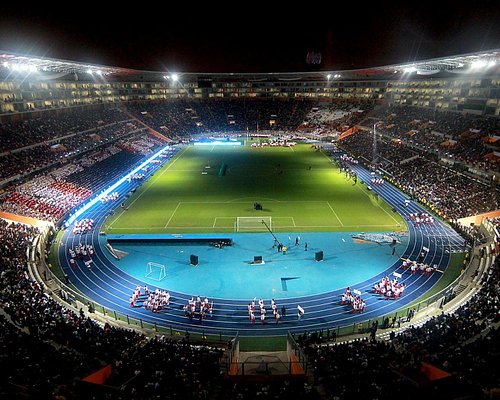Altitude Training: Enhancing Performance on the Field
Altitude training has become an integral part of many professional athletes’ training regimes, including footballers. This blog aims to shed light on what altitude training is and explore why it has gained widespread popularity among football players. By enhancing endurance, strengthening lung capacity, and improving overall performance, altitude training has become an essential tool for footballers looking to gain a competitive edge on the field.

Altitude training involves exposing athletes to reduced levels of oxygen present at high altitudes. This is achieved by training and living at higher elevations, typically above 1,500 meters (4,900 feet) above sea level. The decreased oxygen availability at high elevations stimulates the body to adapt by increasing red blood cell count, improving oxygen transportation, and enhancing aerobic capacity.
Football matches often demand high endurance levels, as players are constantly running, sprinting, and changing directions. Altitude training allows players to train in an environment with lower oxygen concentrations, forcing the body to adapt and improve its oxygen utilization efficiency. As a result, footballers develop better endurance and can sustain high-intensity efforts throughout the duration of a match, ultimately improving their overall performance on the field.
With the respiratory system under strain at high altitudes, altitude training prompts footballers to consciously take deeper breaths and develop stronger respiratory muscles. This increases lung capacity and strengthens the diaphragm, enabling players to intake more oxygen during matches. Enhanced lung function allows footballers to maximize their aerobic capacity, leading to improved stamina and quicker recovery from intense physical exertion.
One of the key advantages of altitude training is its ability to enhance performance even when athletes return to sea level. Footballers who have undergone altitude training possess a higher concentration of red blood cells, enabling them to carry more oxygen to their muscles. This advantage translates into improved performance when competing at lower altitudes, giving altitude-trained footballers an edge over their opponents who have not undergone such training.
Blood doping is a term commonly used in the realm of sports and refers to the practice of enhancing one’s athletic performance by artificially increasing the amount of red blood cells or the oxygen-carrying capacity of the blood. This controversial technique has been in existence for several decades and has been utilized by athletes in various disciplines in the pursuit of gaining a competitive edge. However, blood doping is considered unethical and illegal in most sporting organizations, as it poses significant health risks to those who engage in it. This essay explores the concept of blood doping, its methods, and the potential consequences associated with this performance-enhancing practice.
Methods of Blood Doping:
There are several methods through which athletes engage in blood doping. One common technique involves the injection of erythropoietin (EPO) into the bloodstream. EPO is a hormone naturally produced by the kidneys that stimulates the production of red blood cells. By injecting external sources of EPO, athletes can increase their red blood cell count, leading to enhanced endurance and performance.
Another method of blood doping involves blood transfusions. Athletes may withdraw their blood weeks or months before a competition and store it to be reinfused later. With this technique, the athlete effectively increases the volume of red blood cells in their bloodstream, resulting in improved oxygen delivery to muscles during physical exertion.
Consequences and Risks:
While blood doping may seem appealing for athletes seeking a competitive advantage, it is important to consider the potential consequences associated with this practice. Firstly, blood doping can have serious health risks. When artificially augmenting the amount of red blood cells in the body, the blood becomes thicker and more viscous. This can lead to an increased risk of blood clots, strokes, and heart attacks.
Furthermore, the abuse of blood doping can disrupt the body’s natural regulatory mechanisms, leading to negative side effects. Excessive EPO use, for example, can cause the blood to become too packed with red blood cells, resulting in a condition known as polycythemia. This condition can elevate blood pressure and impair blood flow to vital organs, potentially leading to organ damage or failure.
Ethical and Legal Implications:
Blood doping is not only a health risk but also a violation of ethical standards in sports. The use of performance-enhancing substances undermines fair competition, as it provides an unfair advantage to those who engage in such practices. Athletes should be rewarded based on their natural abilities, training, and dedication, rather than on the use of artificial means to enhance their performance.
Sports organizations and governing bodies take a strong stance against blood doping due to its unethical nature. Various anti-doping agencies have implemented comprehensive testing methods to identify blood-doping substances and techniques. Those found guilty of blood doping can face severe penalties, including disqualification from competitions, loss of titles, suspension, and even bans from participating in sports for extended periods, tarnishing their careers and reputations.
Conclusion:
Blood doping is a performance-enhancing practice that involves artificially increasing the amount of red blood cells or the oxygen-carrying capacity of the blood. While it may offer short-term benefits in enhancing athletic performance, the consequences and risks associated with blood doping are significant. From potential health complications to the ethical implications in sports, blood doping is firmly condemned by sports organizations. Upholding the principles of fair play and maintaining the integrity of sports should be prioritized over achieving temporary success through artificial means.
Altitude training not only strengthens the body but also fosters mental resilience in footballers. Training at high altitudes can be physically demanding and mentally challenging due to the decreased oxygen availability. Overcoming these obstacles helps athletes develop a strong mindset, which is vital for success on the football field. The mental fortitude acquired during altitude training can positively influence players’ confidence levels, decision-making abilities, and focus during high-pressure situations in matches.
Altitude training has increasingly gained popularity among footballers as a means to enhance their performance and physical capabilities. Training in high-altitude environments offers several physiological benefits, including improved oxygen utilisation, increased red blood cell count, and enhanced endurance. Choosing the perfect destination for altitude training is crucial for footballers seeking optimal results. In this essay, we will explore some of the best locations for altitude training and discuss the factors that make them ideal choices for footballers.
Factors to Consider:
When selecting a destination for altitude training, it is essential to consider various factors that can contribute to an effective training experience. Some key factors to consider include altitude levels, infrastructure, climate, accessibility, training facilities, and accommodation options.
1. La Paz, Bolivia:
La Paz, the administrative capital of Bolivia, is often considered one of the premier destinations for altitude training due to its remarkably high altitude. Situated at an elevation of approximately 3,650 meters (11,975 feet) above sea level, the city provides athletes with a significant physiological challenge. La Paz offers a range of training facilities and ample high-altitude accommodation options, providing an environment that caters specifically to athletes’ needs. The city’s climate, with cool and dry summers, accommodates year-round training without extreme weather interruptions.

2. Quito, Ecuador:
Quito, the capital city of Ecuador, is another excellent choice for footballers seeking altitude training. Sitting at an elevation of around 2,850 meters (9,350 feet), Quito provides a moderate altitude that promotes gradual adaptation. The city boasts excellent infrastructure, including quality training facilities and a variety of accommodations. Additionally, Quito’s mild climate, with average temperatures ranging from 50 to 70 degrees Fahrenheit, helps create a comfortable training environment year-round.

3. Cusco, Peru:
Cusco, the historic city nestled in the Peruvian Andes, offers a high-altitude training paradise. Located at an elevation of approximately 3,400 meters (11,200 feet), Cusco provides footballers with an ideal environment for altitude adaptation. The city offers access to world-class sports facilities and training centers, combining professional facilities with breath taking scenery. Accommodation options, ranging from luxury hotels to budget-friendly hostels, cater to athletes of all levels. However, it is worth noting that Cusco experiences more significant temperature fluctuations and occasional rain, requiring additional preparation for training sessions.

4. Flagstaff, Arizona, United States:
While not at the same altitude level as some international destinations, Flagstaff in Arizona, USA, offers a unique training experience due to its high elevation. Situated at around 2,100 meters (7,000 feet), Flagstaff provides a moderate altitude suitable for gradual adaptation. The city is home to numerous high-performance training centers, including altitude chambers and elite sports facilities. Its well-established sports community and welcoming climate, with mild summers and snowy winters, make Flagstaff an attractive choice for both domestic and international football teams.

In conclusion...
When it comes to altitude training for footballers, careful consideration must be given to choosing the right destination. La Paz, Bolivia, Quito, Ecuador, Cusco, Peru, and Flagstaff, Arizona, are among the top choices due to their varying altitude levels, quality infrastructure, favourable climates, and accessible training facilities. However, it is essential for footballers and their coaching staff to evaluate their specific training goals and adaptability to different altitudes when making a decision. Ultimately, selecting a conducive altitude training destination can significantly contribute to a footballer’s success by improving endurance, oxygen utilisation, and overall physical performance.
Altitude training has become an essential part of many professional footballers’ training programs due to the numerous benefits it offers. By improving endurance, strengthening lung capacity, and promoting mental resilience, altitude training enhances footballers’ overall performance. With its ability to provide a competitive edge on the field, altitude training has proven to be a valuable tool for footballers looking to maximize their potential and succeed at the highest level of the game.
Author: S. Noakes






